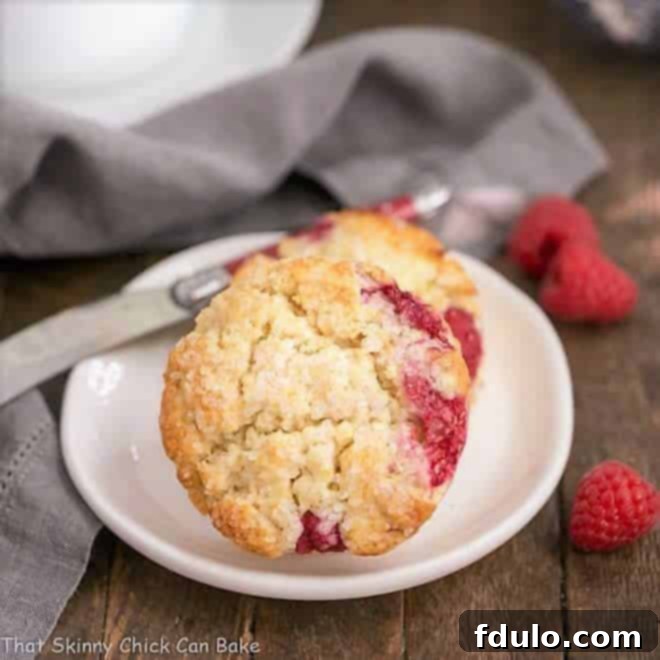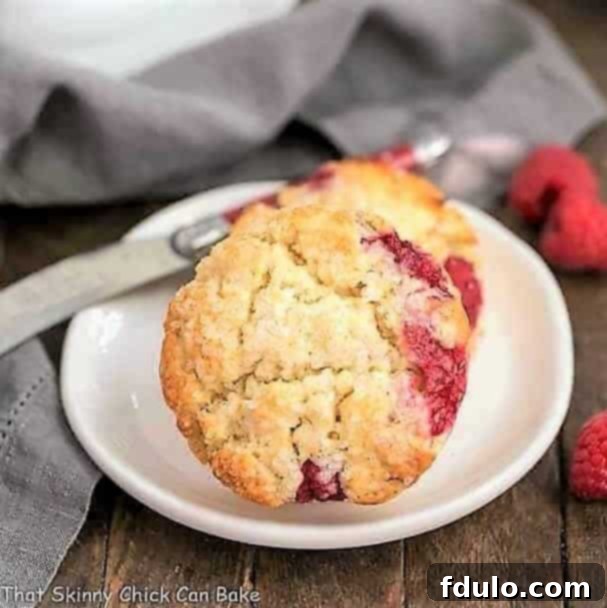Welcome to the ultimate guide for creating truly exceptional Raspberry Cream Scones. When you’re looking to impress guests for a delightful brunch, an elegant afternoon tea, or simply craving a sophisticated treat for yourself, these scones are an undeniable choice. Crafted with the richness of heavy cream and bursting with the vibrant sweetness of fresh raspberries, this recipe promises scones that are not just good, but remarkably tender, moist, and utterly irresistible. Forget dry, crumbly pastries – these are the kind of scones that redefine your baking expectations, offering a perfect texture that melts in your mouth and a flavor profile that sings of summer.
Each bite delivers a delicate balance of buttery richness and fruity tang, making them a standout addition to any breakfast spread or dessert table. Prepare to elevate your baking skills and delight everyone with these truly amazing homemade raspberry cream scones, a recipe so fantastic it will surely become a cherished favorite in your kitchen.

Why You Must Make These Raspberry Cream Scones
If your quest for the perfect scone recipe has felt endless, your search concludes here. This recipe for raspberry cream scones is not just a collection of instructions; it’s a gateway to baking bliss. Here’s why these delectable pastries deserve a prime spot in your baking repertoire:
- Unrivaled Tenderness: The secret lies in the generous inclusion of heavy cream, which infuses the dough with an incredible richness and guarantees a wonderfully tender crumb. Unlike many scone recipes that can yield dry or tough results, ours ensures a consistently moist and delicate texture.
- Effortless Preparation: Don’t let their elegant appearance fool you; these raspberry cream scones come together surprisingly quickly. The simple mixing process, combined with straightforward steps, makes them an achievable and rewarding project for bakers of all skill levels, even on a busy morning.
- Bursting with Flavor: Luscious, plump red raspberries are folded into the dough, providing bursts of tangy-sweet fruitiness with every bite. The contrast between the rich scone and the bright berries is simply irresistible, making them far more tempting than plain scones.
- Crowd-Pleasing Perfection: These scones consistently earn rave reviews, even without traditional accompaniments like clotted cream. They are truly excellent on their own, showcasing their inherent deliciousness. However, feel free to elevate the experience further by serving them with a dollop of butter, your favorite jam, tangy lemon curd, or the classic clotted cream.
- Versatile and Adaptable: While fresh raspberries are a star, this recipe is incredibly flexible. Experiment by swapping out raspberries for other seasonal berries like blueberries, blackberries, or chopped strawberries to create an endless array of delicious variations tailored to your taste.
- A Touch of Elegance: Serving homemade raspberry cream scones instantly elevates any meal, transforming an ordinary breakfast or afternoon snack into a special occasion. Their rustic charm and exquisite taste make them ideal for entertaining or simply treating yourself to a moment of culinary indulgence.
This isn’t just a recipe; it’s an invitation to experience the sheer delight of perfectly baked scones.
Key Ingredients for Perfect Raspberry Cream Scones
Crafting truly exceptional raspberry cream scones begins with understanding the role of each ingredient. Quality and proper handling are paramount to achieving that coveted tender, flaky texture and vibrant flavor. Here’s a breakdown of what you’ll need and why:
- All-Purpose Flour: This is the standard choice for most home bakers and works beautifully for scones. However, for an even softer, more tender crumb, consider using pastry flour or cake flour. These flours have a lower protein content, which translates to less gluten development and thus a more delicate texture. If using all-purpose, avoid overworking the dough to prevent toughness.
- Baking Powder: The primary leavening agent in scones, baking powder is crucial for their rise and light texture. Always check the expiration date, as baking powder loses its potency over time, often much faster than baking soda. An old, inactive leavening agent will result in flat, dense scones, so freshness is key for a good rise.
- Granulated Sugar: Regular white granulated sugar provides just the right amount of sweetness to complement the tart raspberries and helps in the browning of the scones. It also contributes to the overall tenderness of the final product.
- Salt: A pinch of salt is essential for balancing and enhancing the flavors of all the other ingredients. It brings out the sweetness of the sugar and the fruit, preventing the scones from tasting bland. I typically use table salt.
- Very Cold Butter: This is perhaps the most critical ingredient for flaky scones. Cold butter, cut into small cubes, creates pockets within the dough. As the scones bake, the butter melts, releasing steam that helps to lift and separate the layers, resulting in a light and flaky texture. I often use salted butter for an extra layer of flavor, and for best results, I cube my butter and place it in the freezer for about 10-15 minutes while I gather other ingredients.
- Fresh or Frozen Raspberries: Both fresh and frozen raspberries work wonderfully in this recipe. If using fresh, gently fold them in to avoid crushing. For frozen berries, there’s a slight advantage: they tend to bleed less color into the dough, maintaining a cleaner appearance. You can freeze fresh berries in a single layer on a rimmed sheet pan first for easier handling and to prevent them from clumping. If using frozen, you might need to add a couple of extra minutes to the baking time.
- Heavy Cream (36% Butterfat): The star of these “cream” scones! Heavy cream is indispensable for achieving their signature richness and moistness. The high butterfat content (ideally around 36%) contributes significantly to the tender texture and luxurious mouthfeel, distinguishing these from drier, more traditional scone varieties. Ensure your cream is cold when adding it to the dough.
By understanding and respecting the role of each ingredient, you’re well on your way to baking the most delicious raspberry cream scones imaginable.

Expert Baking Tips for Fluffy and Tender Scones
Have you ever encountered a scone that was disappointingly dry, crumbly, or utterly flavorless? It’s a common baking pitfall, but with a few expert tips, you can ensure every scone you bake is perfectly moist, tender, and bursting with flavor. Say goodbye to subpar scones forever with these crucial techniques:
- Embrace Cold, High-Quality Butter: This is perhaps the most vital tip for achieving truly flaky scones. Always use very cold butter. The colder the butter, the better it will create pockets of steam during baking, which is essential for a light, airy texture. Consider splurging on European butter; its higher butterfat content contributes to a richer flavor and even more tender results. I highly recommend cubing your butter and then placing it in the freezer for 10-15 minutes while you prepare the dry ingredients. This ensures it stays firm and cold.
- The Science of Steam: The cold butter acts as a leavening agent in conjunction with your baking powder. As the butter melts rapidly in the hot oven, it releases steam, which helps to separate the layers of dough and create that desirable flaky texture. This is why keeping everything cold is so important.
- PRO-Tip: Handle Dough Minimally: The golden rule for tender scones is to avoid over-mixing or overworking your dough. Excessive handling develops gluten, which can lead to tough, chewy scones. You want the dough to just come together, and it’s perfectly fine—in fact, desirable—to see small pieces of butter still visible throughout the dough. These butter chunks are your secret weapon for flakiness.
- Check Your Baking Powder: Baking powder is a perishable ingredient that loses its effectiveness over time. Always check the expiration date before you start baking. An old, inactive product will prevent your scones from rising properly, leading to dense results. (And as a crucial reminder, do not substitute baking soda for baking powder; they are not interchangeable for this type of recipe.)
- Achieve Perfect Shapes: For classic round scones, a biscuit cutter is your best friend. Press the cutter straight down into the dough without twisting. Twisting seals the edges of the dough, which can inhibit the scones from rising fully and evenly. A clean, straight cut allows for maximum lift.
- Alternative Cutting Method: If you don’t have a biscuit cutter, you can pat the dough into a circular shape (about 1-inch thick) and then cut it into wedges, similar to how you’d slice a pie.
- The Freezer Chill Before Baking: After shaping your scones, place the entire pan in the freezer for 10-15 minutes while your oven preheats to its target temperature. This quick chill ensures the butter becomes super cold again, maximizing the steam production and resulting in a higher rise and flakier texture. Think of it like a mini shock treatment for the butter!
- Hot Oven, Cold Dough: This principle applies to many laminated pastries, including scones and biscuits. Ensuring your unbaked scones are cool or cold when they enter a hot oven is key to achieving that beautiful puff and tender interior.
- Best When Fresh: Scones are at their absolute peak on the day they are baked. While they can be stored, their freshness and tender texture are unmatched when enjoyed warm from the oven. Keep this in mind when planning your baking schedule.
- Consider Pastry Flour: As mentioned in the ingredient notes, some sources advocate for pastry flour over all-purpose. This makes excellent sense from a baking science perspective, as pastry flour’s lower gluten content will indeed yield softer, more delicate scones. If you have it on hand, it’s worth a try for an even more luxurious texture.
- Don’t Flatten Too Much: When patting out the dough, aim for a thickness of about 1 inch. If the dough is too thin, the scones won’t have enough height to rise properly, resulting in flatter, denser pastries.
By following these expert tips, you’ll consistently bake raspberry cream scones that are the epitome of light, flaky, and tender perfection.

Frequently Asked Questions About Raspberry Cream Scones
Absolutely! Frozen raspberries work exceptionally well in scones. In fact, many bakers prefer them because they are less likely to bleed their juices into the dough, helping to maintain a cleaner, more vibrant appearance. There’s no need to thaw them beforehand; simply toss them into the dough while still frozen. You might find that scones made with frozen berries require an extra 2-4 minutes of baking time, so keep an eye on their color and doneness.
Yes, scones freeze beautifully, making them an excellent make-ahead option. To freeze baked scones, allow them to cool completely to room temperature. Then, wrap each scone individually in plastic wrap, followed by a layer of aluminum foil, or place them in a single layer in an airtight freezer-safe container. They can be frozen for up to 2 months. To reheat, simply thaw at room temperature or warm them gently in a microwave or oven until heated through.
Scones are notoriously delicate and lose their fresh quality quickly; they truly are best enjoyed on the day they are baked. To maximize their freshness and keep them as moist as possible for up to two days, ensure they are completely cooled before storing. Once cool, place them in an airtight container at room temperature. If your kitchen is particularly humid, consider adding a paper towel to the container to help absorb any excess moisture, which can otherwise make them soggy. For slightly longer storage, you can refrigerate them, though this can sometimes alter their texture slightly.
Scones are incredibly versatile and pair well with a variety of accompaniments. The traditional choice, of course, is a pot of freshly brewed tea, but excellent coffee is also a must-offer. Beyond beverages, the classic toppings include a generous dollop of clotted cream (the quintessential British pairing), your favorite fruit jams (raspberry, strawberry, or apricot work wonderfully), and zesty lemon curd. For a complete breakfast or brunch menu, consider serving your raspberry cream scones alongside fresh fruit salad, creamy yogurt, savory bacon or ham, and perhaps other delightful pastries to create a truly memorable spread.
You May Also Like These Delicious Brunch & Scone Recipes
- Almond Peach Scones from Saving Room for Dessert – A wonderful seasonal treat.
- Fresh Blackberry Scones – Another berry-filled delight, perfect for summer.
- Vanilla Bean Scones – A classic, aromatic choice that’s always a hit.
- Cranberry Eggnog Scones – A festive and flavorful option for the holiday season.
- Plus, explore more Delicious Brunch Recipes for endless inspiration!
Stay connected and share your culinary creations with me! Find me on social media @ Instagram, Facebook, and Pinterest. Don’t forget to tag me when you try one of my recipes! If you love the results and enjoyed this recipe, please consider giving it a 5-star rating in the recipe card below to help other bakers find this amazing treat.

Raspberry Cream Scones
15 minutes
14 minutes
29 minutes
8 servings
Moist and tender scones, generously filled with ripe, fresh raspberries, offering a delightful texture and burst of flavor.
Ingredients
- 2 cups all-purpose flour
- 1 tablespoon baking powder (freshly checked for expiration)
- 3 tablespoons granulated sugar
- ½ teaspoon salt
- 5 tablespoons very cold butter, cut into ¼-inch cubes
- ½ cup fresh raspberries (or frozen, unthawed)
- 1 cup heavy cream (36% butterfat), very cold
Instructions
- Preheat your oven to 425°F (220°C).
- In a large mixing bowl, combine the flour, baking powder, sugar, and salt. Whisk these dry ingredients together thoroughly to ensure even distribution.
- Add the cubed cold butter to the dry ingredients. Using a pastry blender or your fingertips, cut the butter into the flour mixture until it resembles coarse cornmeal with some pea-sized lumps of butter remaining. Gently fold in the raspberries, taking care not to crush them.
- Pour in the cold heavy cream. Stir with a spatula or fork until the dough just begins to form and looks shaggy.
- Turn the dough out onto a lightly floured countertop. Knead very gently, just enough for the dough to come together into a slightly sticky mound, approximately 5-10 seconds. Avoid overworking the dough.
- Pat the dough into a rectangle or circle about 1 inch (2.5 cm) thick. Using a biscuit cutter, cut out 8-12 rounds, pressing straight down without twisting. Gather any scraps and gently re-pat to cut additional scones.
- Place the cut scones onto a baking sheet lined with parchment paper or a Silpat. If desired, you can brush the tops with a little extra cream and sprinkle with sugar for a golden finish.
- Bake for 11-14 minutes, or until the scones are light golden brown and have risen well. Baking time may vary depending on your oven and whether you used fresh or frozen raspberries.
- Allow the scones to cool on a wire rack for at least 10 minutes before serving. They are best served warm or at room temperature on the day they are made. These scones also freeze exceptionally well for later enjoyment.
- Optional: For those who prefer, these scones can also be made using a food processor. Add dry ingredients, then pulse in butter until crumbly. Add cream and pulse briefly until just combined, being careful not to over-process.
Notes
Yield varies depending on the size of your biscuit cutter.
Frozen raspberries work well, too. You may need to bake a little longer to adjust for the frozen fruit.
These are best on the day made. Freeze leftovers and just pop in the microwave for a delicious treat.
Adapted from America’s Test Kitchen for perfect results every time.
Recommended Baking Tools
As an Amazon Associate and member of other affiliate programs, I earn from qualifying purchases, helping to support this blog.
- Biscuit Cutters Set
- Stainless Steel Pastry Blender
- OXO Good Grips Balloon Whisk
Nutrition Information:
Yield:
8
Serving Size:
1 scone
Amount Per Serving:
Calories: 302Total Fat: 18gSaturated Fat: 11gTrans Fat: 1gUnsaturated Fat: 6gCholesterol: 53mgSodium: 381mgCarbohydrates: 31gFiber: 1gSugar: 6gProtein: 4g
Share Your Scone Success!
Loved this recipe? Please leave a comment on the blog or share a photo of your beautiful scones on Pinterest and tag me!
